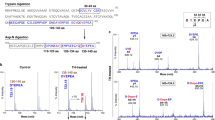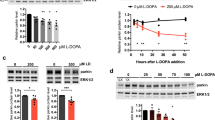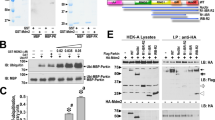Abstract
Inherited mutations in PARK2, the gene encoding parkin, cause selective degeneration of catecholaminergic neurons in the substantia nigra and locus coeruleus of the brainstem, resulting in early-onset parkinsonism. But the role of parkin in common, sporadic forms of Parkinson disease remains unclear. Here we report that the neurotransmitter dopamine covalently modifies parkin in living dopaminergic cells, a process that increases parkin insolubility and inactivates its E3 ubiquitin ligase function. In the brains of individuals with sporadic Parkinson disease, we observed decreases in parkin solubility consistent with its functional inactivation. Using a new biochemical method, we detected catechol-modified parkin in the substantia nigra but not other regions of normal human brain. These findings show a vulnerability of parkin to modification by dopamine, the principal transmitter lost in Parkinson disease, suggesting a mechanism for the progressive loss of parkin function in dopaminergic neurons during aging and sporadic Parkinson disease.
This is a preview of subscription content, access via your institution
Access options
Subscribe to this journal
Receive 12 print issues and online access
$209.00 per year
only $17.42 per issue
Buy this article
- Purchase on Springer Link
- Instant access to full article PDF
Prices may be subject to local taxes which are calculated during checkout





Similar content being viewed by others
Change history
18 October 2005
Replaced Supp Info
Notes
NOTE: In the version of this article initially published online, the Supplementary Methods contained two extraneous phrases. The error has been corrected for the HTML version of the article.
References
Dauer, W. & Przedborski, S. Parkinson's disease: mechanisms and models. Neuron 39, 889–909 (2003).
Kitada, T. et al. Mutations in the parkin gene cause autosomal recessive juvenile parkinsonism. Nature 392, 605–608 (1998).
Hayashi, S. et al. An autopsy case of autosomal-recessive juvenile parkinsonism with a homozygous exon 4 deletion in the parkin gene. Mov. Disord. 15, 884–888 (2000).
Farrer, M. et al. Lewy bodies and parkinsonism in families with parkin mutations. Ann. Neurol. 50, 293–300 (2001).
Pramstaller, P.P. et al. Lewy body Parkinson's disease in a large pedigree with 77 Parkin mutation carriers. Ann. Neurol. 58, 411–422 (2005).
Stokes, A.H., Hastings, T.G. & Vrana, K.E. Cytotoxic and genotoxic potential of dopamine. J. Neurosci. Res. 55, 659–665 (1999).
Zecca, L., Zucca, F.A., Wilms, H. & Sulzer, D. Neuromelanin of the substantia nigra: a neuronal black hole with protective and toxic characteristics. Trends Neurosci. 26, 578–580 (2003).
Sulzer, D. et al. Neuromelanin biosynthesis is driven by excess cytosolic catecholamines not accumulated by synaptic vesicles. Proc. Natl Acad. Sci. USA 97, 11869–11874 (2000).
LaVoie, M.J. & Hastings, T.G. Dopamine quinone formation and protein modification associated with the striatal neurotoxicity of methamphetamine: evidence against a role for extracellular dopamine. J. Neurosci. 19, 1484–1491 (1999).
Hastings, T.G., Lewis, D.A. & Zigmond, M.J. Role of oxidation in the neurotoxic effects of intrastriatal dopamine injections. Proc. Natl Acad. Sci. USA 93, 1956–1961 (1996).
Xu, J. et al. Dopamine-dependent neurotoxicity of alpha-synuclein: a mechanism for selective neurodegeneration in Parkinson disease. Nat. Med. 8, 600–606 (2002).
Dong, Z. et al. Dopamine-dependent neurodegeneration in rats induced by viral vector-mediated overexpression of the parkin target protein, CDCrel-1. Proc. Natl Acad. Sci. USA 100, 12438–12443 (2003).
Kuhn, D.M., Arthur, R.E., Jr, Thomas, D.M. & Elferink, L.A. Tyrosine hydroxylase is inactivated by catechol-quinones and converted to a redox-cycling quinoprotein: possible relevance to Parkinson's disease. J. Neurochem. 73, 1309–1317 (1999).
Kuhn, D.M. & Arthur, R., Jr. Dopamine inactivates tryptophan hydroxylase and forms a redox-cycling quinoprotein: possible endogenous toxin to serotonin neurons. J. Neurosci. 18, 7111–7117 (1998).
Berman, S.B. & Hastings, T.G. Inhibition of glutamate transport in synaptosomes by dopamine oxidation and reactive oxygen species. J. Neurochem. 69, 1185–1195 (1997).
Berman, S.B., Zigmond, M.J. & Hastings, T.G. Modification of dopamine transporter function: effect of reactive oxygen species and dopamine. J. Neurochem. 67, 593–600 (1996).
Xu, Y., Stokes, A.H., Roskoski, R., Jr. & Vrana, K.E. Dopamine, in the presence of tyrosinase, covalently modifies and inactivates tyrosine hydroxylase. J. Neurosci. Res. 54, 691–697 (1998).
Dawson, T.M. & Dawson, V.L. Molecular pathways of neurodegeneration in Parkinson's disease. Science 302, 819–822 (2003).
Hedrich, K. et al. The importance of gene dosage studies: mutational analysis of the parkin gene in early-onset parkinsonism. Hum. Mol. Genet. 10, 1649–1656 (2001).
Hilker, R. et al. The striatal dopaminergic deficit is dependent on the number of mutant alleles in a family with mutations in the parkin gene: evidence for enzymatic parkin function in humans. Neurosci. Lett. 323, 50–54 (2002).
West, A. et al. Complex relationship between Parkin mutations and Parkinson disease. Am. J. Med. Genet. 114, 584–591 (2002).
Winklhofer, K.F., Henn, I.H., Kay-Jackson, P.C., Heller, U. & Tatzelt, J. Inactivation of parkin by oxidative stress and C-terminal truncations: a protective role of molecular chaperones. J. Biol. Chem. 278, 47199–47208 (2003).
Sulzer, D. et al. Amphetamine redistributes dopamine from synaptic vesicles to the cytosol and promotes reverse transport. J. Neurosci. 15, 4102–4108 (1995).
Ardley, H.C., Tan, N.G., Rose, S.A., Markham, A.F. & Robinson, P.A. Features of the parkin/ariadne-like ubiquitin ligase, HHARI, that regulate its interaction with the ubiquitin-conjugating enzyme, Ubch7. J. Biol. Chem. 276, 19640–19647 (2001).
Pawlyk, A.C. et al. Novel monoclonal antibodies demonstrate biochemical variation of brain parkin with age. J. Biol. Chem. 278, 48120–48128 (2003).
Goldberg, M.S. et al. Parkin-deficient mice exhibit nigrostriatal deficits but not loss of dopaminergic neurons. J. Biol. Chem. 278, 43628–43635 (2003).
Jiang, H., Ren, Y., Zhao, J. & Feng, J. Parkin protects human dopaminergic neuroblastoma cells against dopamine-induced apoptosis. Hum Mol Genet (2004).
Imai, Y. et al. An unfolded putative transmembrane polypeptide, which can lead to endoplasmic reticulum stress, is a substrate of Parkin. Cell 105, 891–902 (2001).
Shimura, H. et al. Familial Parkinson disease gene product, parkin, is a ubiquitin-protein ligase. Nat. Genet. 25, 302–305 (2000).
Ciechanover, A. & Brundin, P. The ubiquitin proteasome system in neurodegenerative diseases: sometimes the chicken, sometimes the egg. Neuron 40, 427–446 (2003).
Sriram, S.R. et al. Familial-associated Mutations Differentially Disrupt the Solubility, Localization, Binding and Ubiquitination Properties of Parkin. Hum Mol Genet (2005).
Cookson, M.R. et al. RING finger 1 mutations in Parkin produce altered localization of the protein. Hum. Mol. Genet. 12, 2957–2965 (2003).
Canet-Aviles, R.M. et al. The Parkinson's disease protein DJ-1 is neuroprotective due to cysteine-sulfinic acid-driven mitochondrial localization. Proc. Natl Acad. Sci. USA 101, 9103–9108 (2004).
Wilson, M.A., St Amour, C.V., Collins, J.L., Ringe, D. & Petsko, G.A. The 1.8-A resolution crystal structure of YDR533Cp from Saccharomyces cerevisiae: a member of the DJ-1/ThiJ/PfpI superfamily. Proc. Natl Acad. Sci. USA 101, 1531–1536 (2004).
Conway, K.A., Rochet, J.C., Bieganski, R.M. & Lansbury, P.T., Jr. Kinetic stabilization of the alpha-synuclein protofibril by a dopamine-alpha-synuclein adduct. Science 294, 1346–1349 (2001).
Lotharius, J. et al. Effect of mutant alpha-synuclein on dopamine homeostasis in a new human mesencephalic cell line. J. Biol. Chem. 277, 38884–38894 (2002).
Baptista, M.J. et al. Co-ordinate transcriptional regulation of dopamine synthesis genes by alpha-synuclein in human neuroblastoma cell lines. J. Neurochem. 85, 957–968 (2003).
Volles, M.J. & Lansbury, P.T., Jr. Zeroing in on the pathogenic form of alpha-synuclein and its mechanism of neurotoxicity in Parkinson's disease. Biochemistry 42, 7871–7878 (2003).
McNaught, K.S., Belizaire, R., Jenner, P., Olanow, C.W. & Isacson, O. Selective loss of 20S proteasome alpha-subunits in the substantia nigra pars compacta in Parkinson's disease. Neurosci. Lett. 326, 155–158 (2002).
McNaught, K.S., Belizaire, R., Isacson, O., Jenner, P. & Olanow, C.W. Altered proteasomal function in sporadic Parkinson's disease. Exp. Neurol. 179, 38–46 (2003).
Chung, K.K. et al. S-nitrosylation of parkin regulates ubiquitination and compromises parkin's protective function. Science 304, 1328–1331 (2004).
Yao, D. et al. Nitrosative stress linked to sporadic Parkinson's disease: S-nitrosylation of parkin regulates its E3 ubiquitin ligase activity. Proc. Natl Acad. Sci. USA 101, 10810–10814 (2004).
LaVoie, M.J. & Hastings, T.G. Peroxynitrite- and nitrite-induced oxidation of dopamine: implications for nitric oxide in dopaminergic cell loss. J. Neurochem. 73, 2546–2554 (1999).
Rosengren, E., Linder-Eliasson, E. & Carlsson, A. Detection of 5-S-cysteinyldopamine in human brain. J. Neural Transm. 63, 247–253 (1985).
Fornstedt, B., Rosengren, E. & Carlsson, A. Occurrence and distribution of 5-S-cysteinyl derivatives of dopamine, dopa and dopac in the brains of eight mammalian species. Neuropharmacology 25, 451–454 (1986).
Cheng, F.C., Kuo, J.S., Chia, L.G. & Dryhurst, G. Elevated 5-S-cysteinyldopamine/homovanillic acid ratio and reduced homovanillic acid in cerebrospinal fluid: possible markers for and potential insights into the pathoetiology of Parkinson's disease. J. Neural Transm. 103, 433–446 (1996).
Spencer, J.P. et al. Conjugates of catecholamines with cysteine and GSH in Parkinson's disease: possible mechanisms of formation involving reactive oxygen species. J. Neurochem. 71, 2112–2122 (1998).
Zucca, F.A. et al. The neuromelanin of human substantia nigra: physiological and pathogenic aspects. Pigment Cell Res. 17, 610–617 (2004).
Sulzer, D. & Zecca, L. Intraneuronal dopamine-quinone synthesis: a review. Neurotox. Res. 1, 181–195 (2000).
Henn, I.H., Gostner, J.M., Lackner, P., Tatzelt, J. & Winklhofer, K.F. Pathogenic mutations inactivate parkin by distinct mechanisms. J. Neurochem. 92, 114–122 (2005).
Acknowledgements
We thank J. Chan (Brigham and Women's Hospital) and M. Frosch (Massachusetts ADRC) for providing human brain tissue, and the patients and their families for tissue donation. We thank E. Pothos and T.G. Hastings for technical expertise and assistance. We also thank S. Appel for the MES dopaminergic neuronal cell line, J. Trojanowski for the PRK8 antibody and N. Hattori and Y. Mizuno for human autosomal recessive Parkinson disease specimens. We are grateful to our many colleagues for providing expression vectors and other reagents and to D. Walsh, V. Cullen, S. Baulac, J. Palacino and R.R. Ratan for helpful discussions and reagents. This work was supported by a grant from the American Parkinson Disease Association (to M.J.L.), Udall Center of Excellence grant NS38375 (to D.J.S., M.G.S.) and a grant from the Harvard Center for Neurodegeneration and Repair (to M.G.S.) and an EMBO Long-Term Fellowship (to A.W.).
Author information
Authors and Affiliations
Corresponding author
Ethics declarations
Competing interests
The authors declare no competing financial interests.
Supplementary information
Supplementary Fig. 1
Characterization of the dopaminergic MES cell line and antibodies used. (PDF 223 kb)
Supplementary Fig. 2
Further examination of dopamine-Parkin interactions and sex, post mortem interval, and age at death of human subjects used in Fig. 4. (PDF 290 kb)
Rights and permissions
About this article
Cite this article
LaVoie, M., Ostaszewski, B., Weihofen, A. et al. Dopamine covalently modifies and functionally inactivates parkin. Nat Med 11, 1214–1221 (2005). https://doi.org/10.1038/nm1314
Received:
Accepted:
Published:
Issue Date:
DOI: https://doi.org/10.1038/nm1314
This article is cited by
-
Toxic interactions between dopamine, α-synuclein, monoamine oxidase, and genes in mitochondria of Parkinson’s disease
Journal of Neural Transmission (2024)
-
Mitochondrial dysfunction in Parkinson’s disease – a key disease hallmark with therapeutic potential
Molecular Neurodegeneration (2023)
-
Role of dopamine in the pathophysiology of Parkinson’s disease
Translational Neurodegeneration (2023)
-
Enhancing antibacterial and anticorrosion properties of 304 stainless steel surfaces: a multi-modification approach based on DA/PEI/SiO2/AMPs
Journal of Coatings Technology and Research (2023)
-
Neurodegenerative Etiology of Aromatic L-Amino Acid Decarboxylase Deficiency: a Novel Concept for Expanding Treatment Strategies
Molecular Neurobiology (2023)



